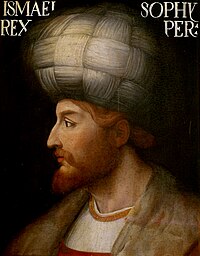Safavid dynasty: Difference between revisions
Discussion is over. All the allegations were proven wrong and intentions behind them exposed. The current variant is incomparably more complete and correct than the agreessively reverted one. |
LIGerasimova (talk | contribs) No edit summary |
||
| Line 1: | Line 1: | ||
{{disputed}}_____________________________________________Caution: Site contains substantial "Turkish Bias" ! |
|||
{{disputed}} |
|||
'''Safavids''', a long-lasting [[Turkic]]-speaking [[Iranian]] dynasty that first established Shiite Islam in Iran as an official religion. |
'''Safavids''', a long-lasting [[Turkic]]-speaking [[Iranian]] dynasty that first established Shiite Islam in Iran as an official religion. |
||
Revision as of 01:21, 10 February 2005
This article's factual accuracy is disputed. |
_____________________________________________Caution: Site contains substantial "Turkish Bias" !
Safavids, a long-lasting Turkic-speaking Iranian dynasty that first established Shiite Islam in Iran as an official religion.
Origins
The Safavid dynasty had its origins in a long established Sufi order which had flourished in Azerbaijan since the early 14th century. Its founder was Sheikh Safi Al-Din (1252-1334), after whom it is named.
Sheikh Safi, or Safi-ad-Din Abul Fath Ishaq Ardabili, came from Ardebil, a city in South Azerbaijan where his shrine exists till our days. He was a disciple of the famed Sufi grand master Sheikh Zahed Gilani (1216 - 1301) of Lahijan. Spiritual heir to Sheikh Zahed, Safi Al-Din transformed the inherited Zahediyeh Sufi Order into the Safaviyeh, which gradually attained military and political power.
The founder of the Safavid kingdom (1501-1736) was Shah Ismail I (ruled 1501-1524). He was a descendant, from his father's side of Sheikh Safi Al-Din and the grandson on his mother's side of Uzun Hasan, the founder of Turkic state of Ak_Koyunlu in Azerbaijan. To help organize the state, the Turkic-speaking Safavid rulers claimed to be descended from Imam Ali, cousin of Prophet Muhammad through the seventh Imam Musa al-Kazim. After coming into power, Shah Ismail I also claimed to have royal Sassanian blood as well.
Rise and Fall of the Safavid State
Over the almost 170 years following the death of Sheikh Safi Al-Din, the Safaviyeh Sufi Order acquired a formidable army and political force. His descendant, Shah Ismail I established his capital in Tabriz in 1501 with the aid of a militia of Turkic soldiers (called Qizilbash, Turkic for "Red Heads" due to their red head gear), recruited from Azerbaijan and eastern Anatolia. During Shah Ismail I rule, the official language at the royal court was Azeri, the Turkic language spoken in Azerbaijan.
At its zenith, during the long reign of Shah Abbas I, the most eminent Safavid monarch, the empire's realms comprised the present day Iran, Iraq, Armenia, Azerbaijan, Georgia, parts of present Turkmenistan, Uzbekistan and Afghanistan.
Fine arts, poetry and sciences flourished under Safavid patronage. Shah Ismail I himself wrote poems in Turkic idiom (present-day Azeri), as well as Persian and Arabic languages. In this period, literature, architecture and handicrafts such as tilemaking, pottery and textiles developed and great advances were made in bookbinding, decoration and calligraphy. XVI c. Tabriz evolved as the center of carpetmaking and miniature painting of the period. Isfahan, being the third and last capital of the Safavids bears the most prominent samples of the Safavid architecture.
Ismail I embraced Shi'a Islam, which he also made mandatory for the whole nation upon penalty of death. Ismail forced conversion of the local population (which was predominantly Sunni at the time) to Shi'ism was the first time this sect had attained such high levels of power in the Islamic world. It would strengthen the rationale for attack by its Sunni neighbors.
The Ottoman Turks and Safavids fought over the fertile plains of Iraq for more than 150 years. The capture of Baghdad by Ismail I in 1509 was only followed by its loss to the Ottoman sultan Suleiman I in 1534. After subsequent campaigns, the Safavids recaptured Baghdad in 1623 yet lost it again to Murad IV in 1638. Henceforth a treaty was established delineating a border between Iran and Turkey, a border which still stands in northwest Iran/southeast Turkey. The century of tug-of-war accentuated the Sunni and Shi'a rift in Iraq.
Constant wars with the Ottomans, made shah Tahmasp I to move the capital from Tabriz, which was occasionally captured by the Ottoman troops, into the inner parts to Kazvin in 1548. Later, Shah Abbas I moved the capital even further to the inner parts of the empire to Isfahan, a Persian city in central Iran. From this time the state began to take on more of a Persian than a Turkic character. In retrospect, what the Safavids did was to succeed in establishing a new Persian national monarchy.
Gradually declining in the 17th and early 18th centuries, effective Safavid rule ended in 1722 after the execution of Shah Soltan Hosein by an Afghan rebel army led by Mir Mahmud, who opposed conversion from Sunni Islam to Shi'a Islam.
The Afghans were prevented from making further gains in Iran by Nadir Shah Afshar, a former soldier who had risen to military leadership within the Afshar Turkoman tribe in Khorosan, a vassal of the Safavids . He had effective control under Tahmasp II and then ruled as regent of the infant Abbas III until 1736 when he had himself crowned shah.
Immediately after Nadir Shah's assassination in 1747, the Safavids were re-appointed as shahs of Iran in order to lend legitimacy to the nascent Zand dynasty. The brief puppet regime of Ismail III ended in 1760 when Karim Khan felt strong enough take nominal power of the country as well.
Safavid Shahs of Iran

- Tahmasp I 1524-1576
- Ismail II 1576-1578
- Mohammed Khodabanda 1578-1587
- Abbas I 1587-1629
- Safi 1629-1642
- Abbas II 1642-1667
- Suleiman I 1667-1694
- Soltan Hoseyn I 1694-1722
- Tahmasp II 1722-1732
- Abbas III 1732-1736
- Suleiman II 1749-1750
- Ismail III 1750-1760
External links
- History of Safavids from a Chamber-of-Commerce-like website. Slightly skewed but colorful and insightful history of the Safavids.
